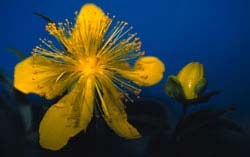Flower Chemicals Both Attract Friends and Deter Foes

Talk about multi-tasking. A new study reveals that in the St. John’s Wort plant, Hypericum calycinum, the same chemical not only attracts pollinating insects but also deters herbivores that pose a threat to its survival. The findings appear in the current issue of the Proceedings of the National Academy of Sciences.
To the human eye, the flowers of H. calycinum appear as uniform yellow disks (top image). Insects with ultraviolet-sensitive eyes, however, see a dark, ultraviolet-absorbing center (bottom image), which acts as a bull’s-eye to help the insects narrow in on the nectar. According to the new research, one class of pigments responsible for this UV pattern is dearomatized isoprenylated phloroglucinols, or DIPs. The investigators also found high concentrations of DIPs on the plant’s reproductive structures, which suggest that the chemicals serve additional purposes in the plant. “Just as important as attracting pollinators to a plant is producing a viable seed,” team member Matthew Gronquist of Cornell University explains, “so there is an evolutionary incentive to protect the reproductive apparatus from herbivores.”
Indeed, the scientists found that hypercalin A, one of the DIPs isolated from H. calycinum, deterred larvae of the rattlebox moth. Those caterpillars unlucky enough to ingest the hypercalin A died. The researchers conclude that DIPs act simultaneously to draw pollinators and discourage predators. “Now that we know where to look,” study co-author Thomas Eisner remarks, “antifeedant chemicals like the DIPs undoubtedly will be found in other plant species, and they offer clues to more natural insect control agents.”
Media Contact
All latest news from the category: Life Sciences and Chemistry
Articles and reports from the Life Sciences and chemistry area deal with applied and basic research into modern biology, chemistry and human medicine.
Valuable information can be found on a range of life sciences fields including bacteriology, biochemistry, bionics, bioinformatics, biophysics, biotechnology, genetics, geobotany, human biology, marine biology, microbiology, molecular biology, cellular biology, zoology, bioinorganic chemistry, microchemistry and environmental chemistry.
Newest articles

First-of-its-kind study uses remote sensing to monitor plastic debris in rivers and lakes
Remote sensing creates a cost-effective solution to monitoring plastic pollution. A first-of-its-kind study from researchers at the University of Minnesota Twin Cities shows how remote sensing can help monitor and…

Laser-based artificial neuron mimics nerve cell functions at lightning speed
With a processing speed a billion times faster than nature, chip-based laser neuron could help advance AI tasks such as pattern recognition and sequence prediction. Researchers have developed a laser-based…

Optimising the processing of plastic waste
Just one look in the yellow bin reveals a colourful jumble of different types of plastic. However, the purer and more uniform plastic waste is, the easier it is to…



